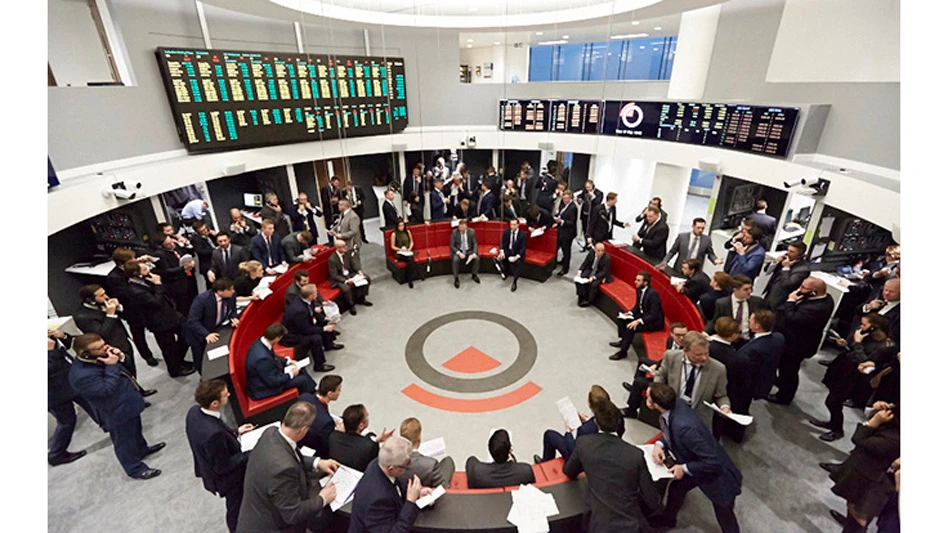
Photo courtesy of the London Metal Exchange
Buyers and sellers of recycled-content metals and the scrap that goes into them have many reasons to hedge their trading positions to help manage risks tied to sudden spikes and drops in prices.
Metals exchanges, including the United States-based Comex, the London Metal Exchange (LME) and the Shanghai Futures Exchange (SHFE), provide warehouse services, benchmark pricing and accompanying trading services tied to those prices.
Recyclers, traders and secondary metal producers in the United States have Comex as the “closest to home” exchange platform, but the LME provides competing services, or in the case of some contracts, a service not replicated by Comex.
Christian Mildner, head of corporate sales at the LME, tells Recycling Today that recycled metals traders have much to consider when selecting an exchange and a specific contract to reference when markets are as volatile as they have been in the 2020s.
Recycling Today (RT): To what extent do customers based in or with a significant presence in North America comprise overall hedging or futures trading activity on the LME?
Christian Mildner (CM): The LME is a global market, and North America is a key production, consumption and trading center for metals representing a significant part of overall LME trading. In 2024, North America represents more than one-quarter of overall client activity on the LME.
Regional North American prices, such as the Midwest premium for aluminum, are typically calculated against the LME’s official settlement price. For that reason, the North American industry can hedge using the LME contract, which offers the largest liquidity pool and removes any basis risk between the hedge and physical exposure.
RT: What services and options are the LME offering that have met with a positive reception from those in the recycling and secondary commodities trading sector?
CM: Aside from our steel scrap contracts, which have seen huge growth in the last couple of years, we are also seeing increased interest from the small-scale secondary lead community looking to list their brands on the LME.
To support their participation and encourage their representation in the deliverable production capacity – which could enhance liquidity in LME lead – the LME has recently introduced a temporary brand listing fee reduction for small-scale secondary lead producers for whom the costs associated with the listing process can be disproportionate, and therefore an impediment to becoming an LME brand.
We hope to see a number of new secondary lead brand listings in the coming months.
RT: In a market where a wide price spread occurs (such as between Comex and LME copper lately), what types of companies might benefit from using the lower-priced exchange?
CM: Recyclers typically reference a given market depending on their preferences and location. That applies both to spot and indexed term contracts. A physical player who has chosen one reference over another will not have time to switch physical supply contracts to another price reference which might temporarily be more advantageous, especially during a short-lived price dislocation.
Companies should choose the reference price they trust. Elements such as liquidity, stability, physical market representation and pricing frequency (daily versus monthly) should be taken into account. The physical metals world is not set up to shift to a different reference price when the wind changes direction.
RT: What services does the LME offer to provide exchange access to North American traders who are several hours removed from London’s time zone?
CM: The LME interoffice market trades 24 hours a day. We have a large network of U.S. and North American clearing brokers and banks that provide access to the LME in the region. You can find them on our website.
North American traders and recyclers typically carry out their hedging activity during the American morning in order to access liquidity when it is deepest. During the American afternoon, liquidity is lower as Asia is closed and London is winding down.
The LME also attends a large number of recycling industry events in North America, such as those organized by ReMA (formerly ISRI). The dialogue with industry users is extremely important for us to gain firsthand industry feedback and provide tailored information on price risk management tools to suit each user’s needs.
RT: In the ferrous sector, how have American buyers and sellers found ways to use the LME’s steel scrap contract in their trading activities?
CM: The LME’s steel scrap contract references the Platts TSI HMS 1/2 CFR Turkey price. Turkey is the world’s center for seaborne steel scrap trading and is the largest export market for American steel scrap. Several North American recyclers and steel mills actively use the contract to manage their steel scrap price risk.
Trading volume and open interest have grown substantially over the last two years, reaching 7.1 million metric tons traded in 2024-to-date versus 8 million metric tons in the whole of 2023.
RT: How can North American traders learn more about the LME and its services?
CM: The easiest way is to get in touch with sales@lme.com or speak to us at one of the industry events. There also are significant online resources available on our website free of charge and dedicated educational courses for those who want to go in depth.
Latest from Recycling Today
- BMW Group, Encory launch 'direct recycling’ of batteries
- Loom Carbon, RTI International partner to scale textile recycling technology
- Goodwill Industries of West Michigan, American Glass Mosaics partner to divert glass from landfill
- CARI forms federal advocacy partnership
- Monthly packaging papers shipments down in November
- STEEL Act aims to enhance trade enforcement to prevent dumping of steel in the US
- San Francisco schools introduce compostable lunch trays
- Aduro graduates from Shell GameChanger program





